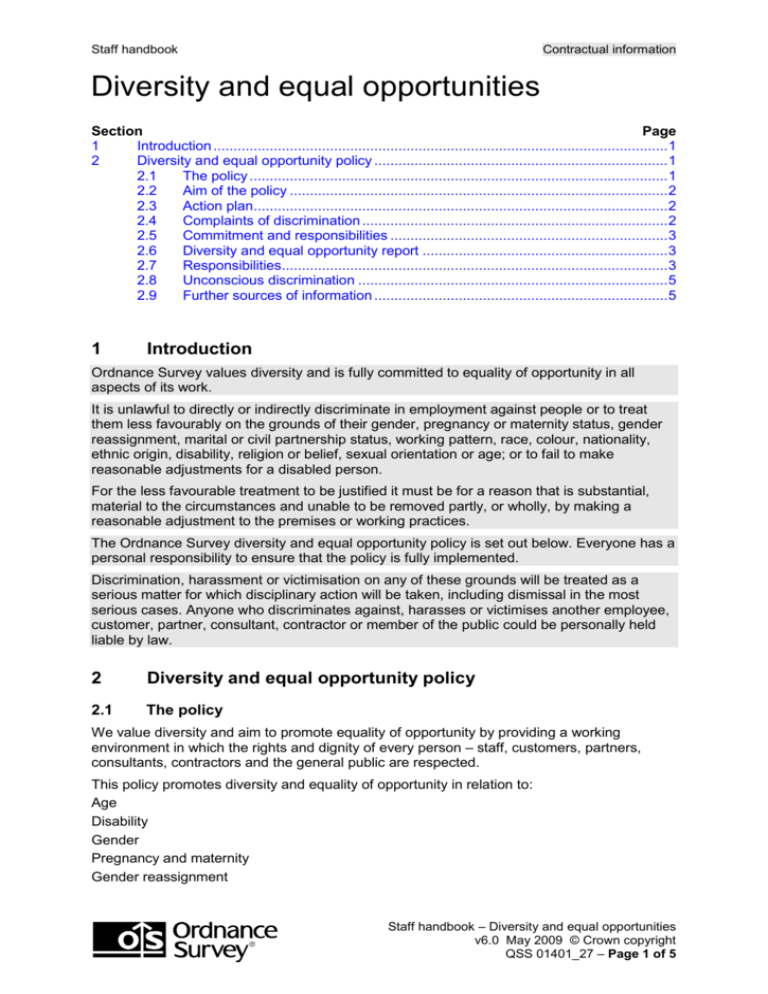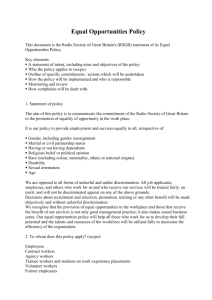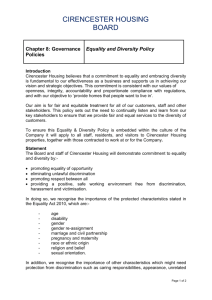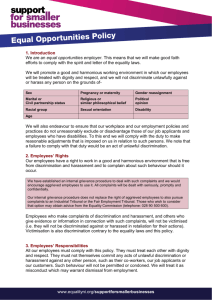Diversity and equal opportunities
advertisement

Staff handbook Contractual information Diversity and equal opportunities Section Page 1 Introduction ................................................................................................................. 1 2 Diversity and equal opportunity policy ......................................................................... 1 2.1 The policy ........................................................................................................ 1 2.2 Aim of the policy .............................................................................................. 2 2.3 Action plan....................................................................................................... 2 2.4 Complaints of discrimination ............................................................................ 2 2.5 Commitment and responsibilities ..................................................................... 3 2.6 Diversity and equal opportunity report ............................................................. 3 2.7 Responsibilities................................................................................................ 3 2.8 Unconscious discrimination ............................................................................. 5 2.9 Further sources of information ......................................................................... 5 1 Introduction Ordnance Survey values diversity and is fully committed to equality of opportunity in all aspects of its work. It is unlawful to directly or indirectly discriminate in employment against people or to treat them less favourably on the grounds of their gender, pregnancy or maternity status, gender reassignment, marital or civil partnership status, working pattern, race, colour, nationality, ethnic origin, disability, religion or belief, sexual orientation or age; or to fail to make reasonable adjustments for a disabled person. For the less favourable treatment to be justified it must be for a reason that is substantial, material to the circumstances and unable to be removed partly, or wholly, by making a reasonable adjustment to the premises or working practices. The Ordnance Survey diversity and equal opportunity policy is set out below. Everyone has a personal responsibility to ensure that the policy is fully implemented. Discrimination, harassment or victimisation on any of these grounds will be treated as a serious matter for which disciplinary action will be taken, including dismissal in the most serious cases. Anyone who discriminates against, harasses or victimises another employee, customer, partner, consultant, contractor or member of the public could be personally held liable by law. 2 Diversity and equal opportunity policy 2.1 The policy We value diversity and aim to promote equality of opportunity by providing a working environment in which the rights and dignity of every person – staff, customers, partners, consultants, contractors and the general public are respected. This policy promotes diversity and equality of opportunity in relation to: Age Disability Gender Pregnancy and maternity Gender reassignment Staff handbook – Diversity and equal opportunities v6.0 May 2009 © Crown copyright QSS 01401_27 – Page 1 of 5 Staff handbook Contractual information Marital status and civil partnership Working pattern Race, ethnic or national origin Religion or belief Sexual orientation 2.2 Aim of the policy We aim to ensure that: all individuals work in an environment in which diversity is valued and which is free from discrimination, prejudice, intimidation, victimisation and all forms of harassment, including bullying; we make the best possible use of the abilities of all of our staff, through career development, training and opportunities for flexible working and where everyone feels able to make a positive contribution; where there is a requirement and it is possible and practical to do so, we adapt premises, working practices and equipment; we work towards achieving a workforce that reflects the relevant national or local labour markets and are positive about recruiting competent individuals from currently under-represented groups; as signatories to the ‘double-tick’ symbol, we are positive about disabled people; and we have a better understanding of, and can provide a better service to a wider and more diverse customer base. 2.3 Action plan Ordnance Survey is committed to a programme of action to ensure that its policy is implemented and monitored at an organisational and individual level. An action plan has been developed to ensure that we continue to integrate the implementation of this policy into mainstream activities across all business functions. A network of group Equality Advocates has been identified, whose terms of reference include the requirement to ensure that the programme of equality impact assessment is implemented in their business areas. We have published our Equality scheme, setting out our programme to meet the statutory duties to promote race, disability and gender equality in all aspects of our work – including the systematic equality impact assessment of product development, service delivery and employment practices. The Equality scheme includes a three-year programme of action for all Business Groups. Equality impact assessment of Human Resources policies cover religion and belief, sexual orientation and age as well as race, disability and gender. Training is provided to support the implementation of this policy via an online e-learning package. 2.4 Complaints of discrimination Any complaints of discrimination, harassment or victimisation should be raised through the harassment policy or the grievance procedure. Staff handbook – Diversity and equal opportunities v6.0 May 2009 © Crown copyright QSS 01401_27 – Page 2 of 5 Staff handbook 2.5 Contractual information Commitment and responsibilities All staff are responsible for the effective implementation of this policy. For the general and specific responsibilities, see section 2.7 below. The Director General and Group Directors are fully committed to this policy. It is in line with central Cabinet Office guidance on diversity and equal opportunities and has the support of Ordnance Survey TUS. The Director of Human Resources and Corporate Services (HRCS) is our Diversity and Equal Opportunities Officer. 2.6 Diversity and equal opportunity report The Assistant Diversity and Equal Opportunities Officer monitors the progress of the diversity and equal opportunities policy, the Equality scheme and the action plan and a report is presented annually to Operating Board and the Departmental Whitley Council (DWC) and TUS Equal Opportunities Officer. The report focuses on: Performance against the action plan. Progress of Equality impact assessments within each Business group. Statistical information based on the monitors below. Activities and events which have helped to promote diversity and equal opportunities. Areas which require further action. Any significant breaches in the policy, plus remedial action implemented to rectify the breach. There are a number of monitors in place that help to provide a clear picture of what is happening in our workforce. Our current monitoring covers: Staff in post Recruitment and selection Resignations Performance assessment Harassment and grievance cases Disciplinary cases Reasonable adjustments for disabled staff Participation in training 2.7 Responsibilities The Director of Human Resources and Corporate Services (HRCS) is responsible for: ensuring that adequate policies and procedures are in place to secure equality of opportunity and a harassment-free working environment; ensuring that policies and procedures (formal and informal) are in place which provide for prompt, sensitive and fair consideration and resolution of grievances relating to alleged harassment, unfair discrimination, victimisation and accessibility barriers; ensuring that employees are aware of the procedure for making complaints and that they may proceed without fear of subsequent victimisation; publicising the name of the Diversity and Equal Opportunities Officer and Assistant Diversity and Equal Opportunities Officer and outlining their role; and working with TUS Equal Opportunities Officer. Ordnance Survey Operating Board is responsible for: ensuring that all employees are aware of the policies and procedures in relation to diversity and equal opportunities and of their rights and responsibilities under these; Staff handbook – Diversity and equal opportunities v6.0 May 2009 © Crown copyright QSS 01401_27 – Page 3 of 5 Staff handbook Contractual information ensuring that all managers are aware of their responsibilities, both to set a good example and to deal promptly, fairly and sensitively with complaints of harassment and discrimination; supporting agreed diversity training opportunities and initiatives; giving all employees equal opportunity to benefit from training, job selection, performance assessment and career development; taking positive steps to involve minority representation in recruitment and selection procedures wherever practicable; and ensuring that the requirements of the statutory equality duties are met, including equality impact assessment of policies and projects. Human Resources is responsible for: planning and organising diversity training opportunities and initiatives; ensuring that disabled employees can attend and participate fully in internal and external training courses arranged by Ordnance Survey, providing that individuals state their requirements; holding an annual open forum for people with disabilities; formulating eligibility criteria for recruitment or internal postings to ensure that they are related to the requirements of the job and are non-discriminatory; ensuring any standardised psychometric tests used in recruitment, training or selection are related to the requirements of the job, are non-discriminatory and are conducted and interpreted by appropriately trained personnel; and ensuring that reasonable adjustment requirements are accessed through the Occupational Health professionals and external professionals such as Access to Work. Managers are responsible for: considering carefully whether their actions or decisions could be directly or indirectly discriminatory against any groups; publicising our commitment to diversity and equality of opportunity; ensuring that access, physical requirements and other necessary facilities are taken into account when accommodation and equipment changes are planned, budgeted and implemented; making reasonable adjustments to premises and working practices to accommodate employees with disabilities; making arrangements, wherever possible, to meet requirements related to religious, cultural and/or physical differences and ensuring that there is no unlawful direct or indirect discrimination on grounds of such differences; when asked about the suitability of employees for posts, basing assessments solely on the extent to which the employee possesses the skills, attributes and competencies required for the job; promoting Ordnance Survey as a diverse employer; treating all harassment and discrimination complaints seriously; and ensuring that Equality Impact Assessments are carried out, where required. Equality Advocates responsibilities include: maintaining the corporate spreadsheet giving advice and guidance to their colleagues on equality related issues coordinating and monitoring the completion of equality impact assessments providing feedback to HR on progress with their action plan providing HR with information on achievements for inclusion in annual progress report Staff handbook – Diversity and equal opportunities v6.0 May 2009 © Crown copyright QSS 01401_27 – Page 4 of 5 Staff handbook Contractual information The Equality advocate’s terms of reference gives details of their role and a full list of responsibilities. All employees are responsible for: behaving in a non-discriminatory way towards colleagues, customers and the public; critically examining their attitudes to people and ensuring that discrimination is not allowed to affect their judgement; carrying out equality impact assessments on work within their remit with the assistance of group Equality Advocates; and avoiding any action which might influence others to discriminate unfairly. 2.8 Unconscious discrimination Some discriminatory behaviour may occur without conscious intention to discriminate. Such behaviour may not give rise to formal complaints, but may, nevertheless, disadvantage the victim. Care should always be taken to guard against the more subtle and unconscious varieties of discrimination which may not easily be recognised. General assumptions and negative stereotypes about the capabilities, characteristics and interests of particular groups should not be allowed to influence the way that they are treated. Conditions or requirements should not be applied without considering whether they operate disproportionately to disadvantage any particular group – that is, whether they are indirectly discriminatory. Any such condition or requirement must be justifiable within the spirit and terms of the legislation listed in section 1 above. Discrimination may show itself in various ways: Employees may be directed into particular types of work on the basis of general assumptions and stereotypes without sufficient regard to their particular attributes and abilities. Preconceptions about abilities or roles may be allowed to affect decisions. For example, the assumption that married women will be unable to move home or would be unwilling to take on senior roles due to family commitments. The allocation of work and the recruitment or promotion of an employee into a particular post may be affected by assumptions about the reactions of other employees, customers and/or members of the public. Assumptions about the ability to communicate may fail to take account of diversity in spoken communication. Alternatives such as English through British Sign Language or English spoken as a second language should be considered. Advertising external vacancies where they are less likely to reach or attract potential applicants from groups that are currently under-represented within Ordnance Survey. 2.9 Further sources of information QSS 01401 Staff handbook – Harassment Equality scheme Equality and Human Rights Commission: www.cehr.org.uk This document has been screened in accordance with the requirements set out in Ordnance Survey's Equality scheme. Staff handbook – Diversity and equal opportunities v6.0 May 2009 © Crown copyright QSS 01401_27 – Page 5 of 5









